Kulich is a sweet yeasted bread that is as pretty as a cake served during Easter. These enriched yeasted loaves are usually made tall and has a soft cake cake-like crumb and texture.
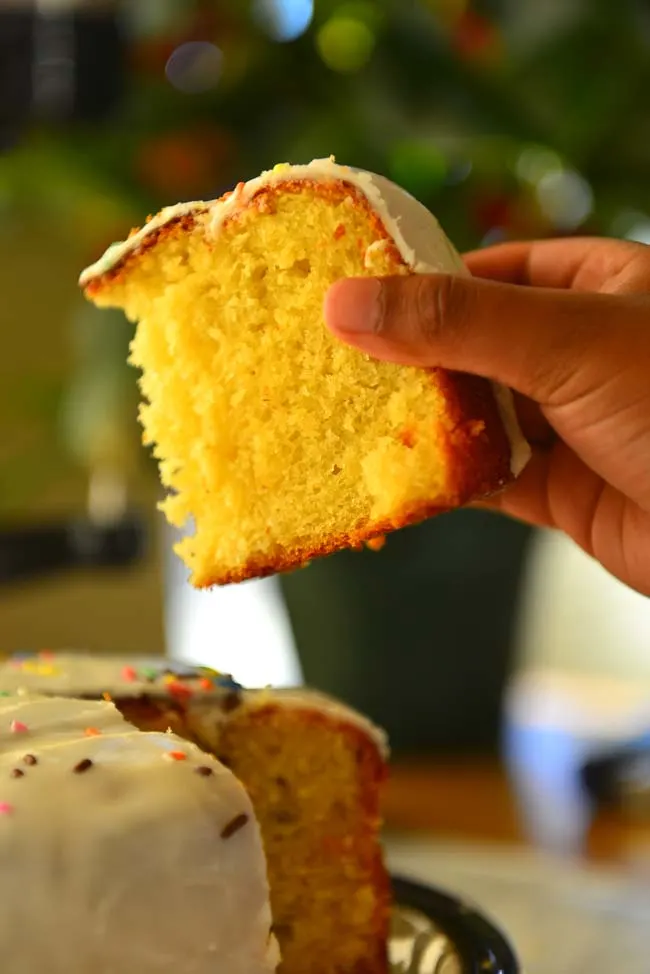
Look at that lovely crumb – it is hard to believe that it belongs to a bread! Well, believe it! This is Kulich a popular Easter bread from Russia. It is essentially a yeasted cake and I, for one, am a big fan.
What Are Yeasted Cakes?
Yeasted cakes are essentially highly enriched bread that relies fully or partially on the yeast action to create the rise and fluffiness while baking. Here my Herman Apple cake uses the Herman starter to do the same. Though these are delicious, usually their crumb tends to be on the drier side when compared to regular cakes. To prevent this bakers soak them in flavored syrups to add some moisture.
Kulich, on the other hand, does not need extra syrup. It is soft and moist on its own. So this has become our latest favorite yeasted cake / celebratory bread. Top with icing and add some sprinkles and it is as pretty as any cake!
Easter Breads
Easter is an especially happy time for the bread baker in me. The days get longer and brighter but still not hot enough for me to worry about the oven heating up the house. What better time to bake brighter, fun loaves! Into this weather add the Easter traditions of creating wonderful, intricate loaves – and I am literally in bread baker heaven.
This time around it is Kulich, the Russian yeasted cake that is heaven on a platter. Kulich is the “Easter cake” for the believers of the Orthodox Christian faith. People of this faith in and around Russia and Eastern European countries make and serve this beautiful loaf during Easter. During the Easter Service, this bread is blessed and later becomes a cherished part of the family feast table.
Here are a few other Easter Breads from around the world.
Ingredients for Kulich
It is essentially an enriched bread – so in addition to the traditional bread ingredients, there are eggs, milk, butter, sugar, dried fruits, nuts, and flavorings. The flavorings and fruits and nuts can vary, and you can leave it even. But it is important to keep the butter, sugar, and eggs in the recipe as these are essential to creating the cake-like crumb.
One another point to note is that do not go overboard with dried fruit and nut. The crumb is very light these are made into tall loaves. So we do not want to overload the crumb with nuts and fruit. If you are new to bread baking, stick with the recipe provided for the first time.
The Secret Ingredient in the Russian Easter Bread – Time
Compared to a regular bread/cake recipe this one is more involved and time-consuming. This is to be expected as it is a traditional celebratory treat. My version is a little pared down one, based on the ingredients that are staples in my pantry. Even then the result is fantastic.
But there is some good news – the active cooking time is 30 to 45 minutes. So if you do not have 5 hours to spare on a single day, refrigerate the dough as soon as it is formed to slow down the rising time. What is even better, the slow-risen down is more flavorful than the regular one – WIN WIN !!!
Making Kulich
I use the stand mixer to make this dough. You can do it by hand, but I would recommend doing it in a bowl rather than the countertop. Even if kneading by hand, use a spatula or spoon to mix the flour in the initial stages.
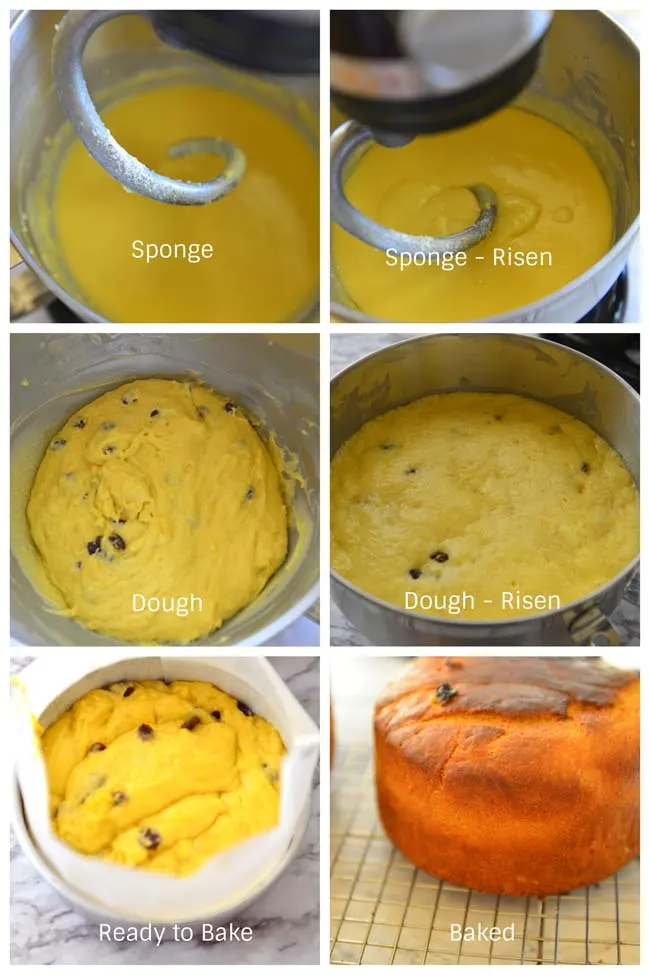
Make the sponge
The process starts by making a sweet sponge. Add the warmed milk (100-110F or barely warm to touch) to the bowl, stir in a little sugar, and sprinkle the yeast on top. Wait for the mix to become bubbly.
To this add the eggs one by one and beating them in. Mix in the melted butter and 1 cup of flour. This is the sponge base. Set it aside in a warm place for an hour to 2 until it has visibly increased in size.
Make the dough
Set the machine at low (or stir) and add the remaining flour to the sponge in batches until the mix comes together in one large mass. Keep kneading the dough for 30 more seconds in the mixer. If kneading by hand, the dough will be a little sticky at first. But as you keep kneading it will pull away from the hand and hold together. Try not to add extra flour.
Fold in the raisins, peels, and almond. Knead for another 30 seconds with the machine set at low until all the ingredients have distributed evenly. You may need to knead a few times by hand to finish this process. Form the dough into a smooth ball (as much as possible).
First rise
Cover the bowl tightly with a plastic wrap or wet kitchen towel and let rise for 2 hours or until the dough is more than doubled in volume. This is a chance for you to slow down the process, if not planning to bake soon. Keep the covered bowl in the fridge for 6 to 8 hours. And bring it back to room temperature before proceeding with the next step.
2nd rise and Shape

Use a spatula to stir and deflate the dough. Here I have divided the dough into 2 six-inch circular cake tins fitted with tall collars. You can use one 8 or 9-inch springform pan as well. Lightly cover the tins and set them aside for 30 to 45 minutes until the dough has risen by about an inch.
Bake
Place the oven rack in the center. Preheat the oven to 350°F.
Bake the loaves for 30 to 35 minutes until the tops are golden. Check on them a little earlier if you are changing the pan sizes or if you have an oven with a top heating element. These tend to rise taller and the tops sometimes come closer to the heating element than you would expect.
Since it is an enriched dough the internal temperature should reach 190°F for it to be cooked through. So if you find that the bread has risen well and is browning fast reduce the temperature to 325°F at around the 20-minute mark. Use this handy temperature conversion guide for temperature equivalences for other types of ovens.
Serving
Remove the baked bread from the oven and let it cool in the pan for 5 to 10 minutes. Transfer to a cooling rack and let it cool completely.
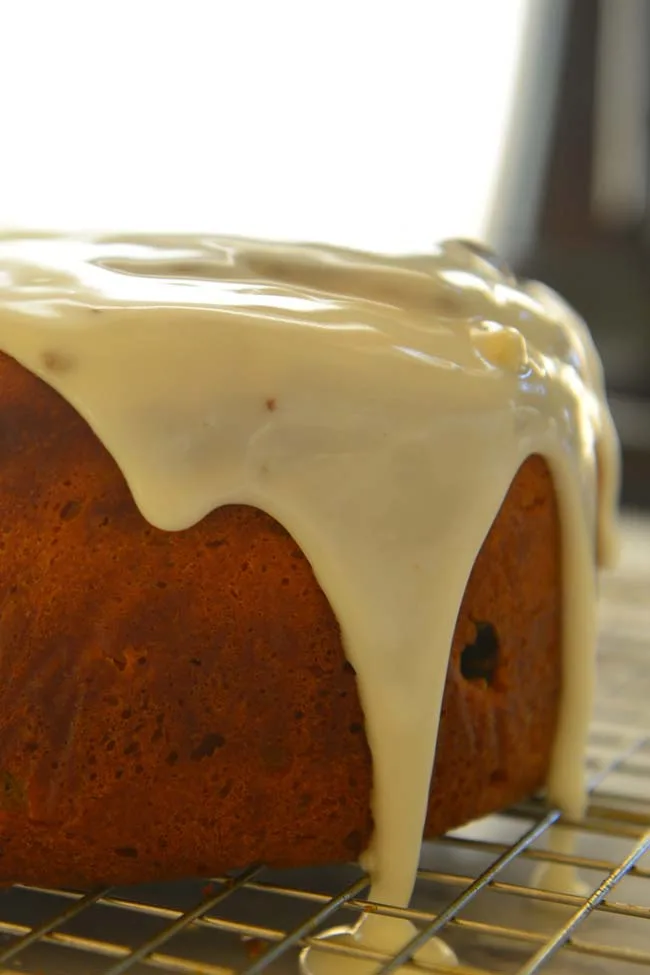
To ice or not
Celebrations call for color and pomp, so yes the answer is ‘ of course, yes ‘!. But kulich tastes great without it too, so I leave it up to you. Here are a few options
- Cover the top with white chocolate ganache (Elegant).
- A cool lemony icing, as in the recipe (Easy and simple).
- Give it a light soaking of rum syrup and serve with a few edible flowers (Grownup version).
Whatever your choice is, it is going to be a treat.
Easter Bread Variations
As traditional recipes go, Kulich also has many variations. Most of the recipes will have some form of dried fruits, usually raisins, or nuts. Some will call for candied citrus peel, chocolate chips, or even sour cream. The spices used could be include cardamom, saffron etc. When it comes to decorating the plain sugar icing seems to be common and spring flowers are used to decorate the loaf, marking the season.
Tall Loaves
These cakes are baked in cans which helps them rise vertically. I have used 6-inch circular pans with 5-inch collars to help the cakes rise without spreading out or creating a muffin top. But if you have aluminum cans that are not coated with plastic, use those to bake these. Popover pans are also a good option to make mini loaves.
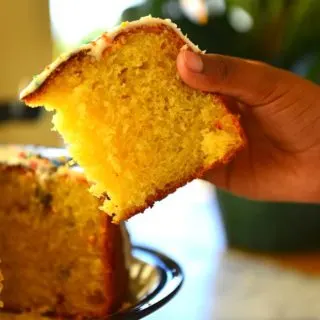
Russian Kulich
Ingredients
- 4 C All-Purpose Flour / Bread Flour 500 g
- 2 ¼ Tsp Active Dry Yeast 1 Pkt / 7g
- 1 C Milk Whole
- 3 Eggs Large
- 1 C Butter
- ¾ C Sugar
- 1 Tsp Brandy
- 1 Tsp Vanilla Extract
- ½ Tsp Salt
- ¼ C Raisins Notes
- ¼ C Candied Citrus Peel Optional
- ¼ C Ground Almonds optional
For Glaze
- 2 C Confectioners sugar
- 2-3 Tbsp Lemon Juice
- Sprinkles
Instructions
Prep
- Warm the milk to 110° F or just warm to touch. Mix in 1 Tbsp sugar and sprinkle the yeast on top. Set aside for 5 minutes for the yeast to activate. Melt the butter (it should be barely warm).
Make the sponge
- Use a stand mixer or a spatula for the next steps.
- Place the activated yeast mix in the mixing bowl. Beat in the eggs one by one. Slowly add the melted butter and sugar while continuing to mix. Add 1C flour in batches. Keep stirring until all the flour is absorbed into the mix. Set aside covered for an hour to 2 until the mix looks visibly bulked up.
Make the Dough
- By MachineSet the machine on stir (lowest setting) and add the salt, vanilla extract, and brandy followed by the remaining flour in batches. In about 2 minutes the mix will come together in one large mass. You may have to scrape the sides to help the process along. Once all the flour is absorbed increase to setting 1 (or the recommended setting for kneading) and knead for another 30 seconds to 1 minute. By now the dough should feel soft and smooth and not sticky.
- By HandUsing a spatula stir the remaining flour, salt, vanilla extract, and brandy into the sponge in batches. Once all the flour is added and absorbed into the sponge, knead by hand for 3 to 5 minutes until the dough feels soft and pliable. It will be sticky in the beginning, but as you knead the texture of the dough changes and it will become less sticky. If absolutely necessary add a couple of tablespoons of extra flour to make it easy to knead.
First Rise
- Add the raisins, peels, and almond. Knead it in by hand until all the ingredients seem to have distributed evenly. Bring the dough together into a smooth mass. Cover the bowl tightly with a plastic wrap or wet kitchen towel and let rise for 2 hours or until the dough is more than doubled in volume.
Shape and 2nd Rise
- Use a spatula to stir and deflate the dough. Divide into 2 six-inch circular cake tins fitted with tall collars or similar pans (Notes). Lightly cover the tins and set them aside for 30 to 45 minutes until the dough has risen by about an inch.
Bake
- Place the oven rack in the center. Preheat the oven to 350°F. Bake the loaves for 30 to 35 minutes until the tops are golden. Since it is an enriched dough the internal temperature should be 190°F. So if the tops are browning faster reduce the oven temperature to 325°F. (Notes)
Serving
- Remove the loaves from the oven and let them cool in the pans for 10 minutes. Transfer to a cooling rack and let them cool completely.
- Mix the icing sugar with lemon juice to make a loose paste. Spread the paste over the tops of the cooled cake. Scatter the sprinkles on top. Slice and serve.
Video
Notes
- Use unbleached flour, preferably organic. All purpose flour or bread flour will work in this recipe.
- Use strips of parchment paper stapled/clipped together to make a circular sleeve in the cake pans. You could use panettone molds as well – these are available online.
- You could use metal cans (plastic free) or popover molds or similar to make these as well. When using these reduce the baking time by at least a third and be sure to check.
- Baking times vary depending on ovens and the tins used. If unsure check on the loaves around 20-25 minutes and adjust the oven temperature if needed.
- Use a mix of dried fruit, nuts and peel. I use ½ C raisins and leave out the almonds and peels.
Important: Nutrition Values are estimates. Actuals vary based on ingredients and serving size.

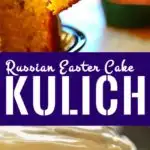


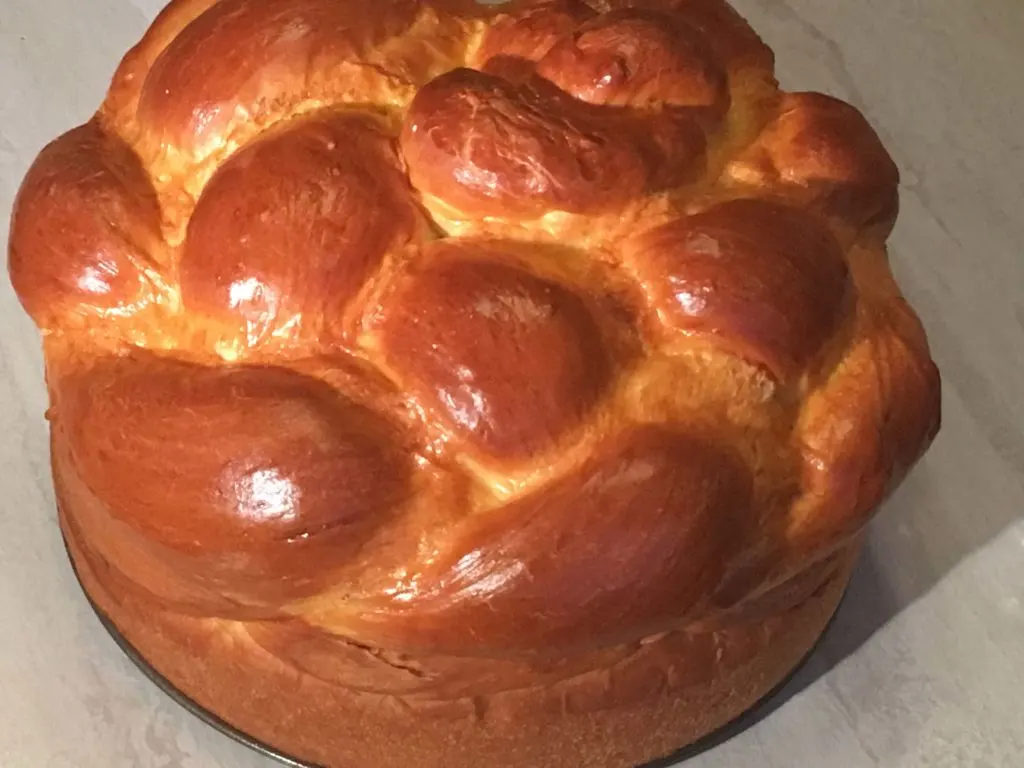
Diane Nonnemacher
Sunday 21st of March 2021
Is it possible to bake the kulich in a Bundt pain? Please share changes in baking length.
Syama
Monday 22nd of March 2021
Hi Diane, It sure is. If you are thinking of a single metal bundt pan it should take roughly the same time, but as ovens and pans vary I would err on the side of caution and check on it at around 30 minutes. I have updated the post and the baking section should give you a better idea on what to watch out for. Happy baking, Syama
All About Tangzhong | OVENTales
Saturday 11th of July 2020
[…] Kulich – Russian Easter Bread […]